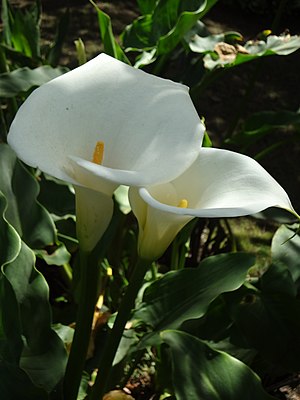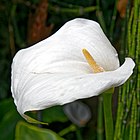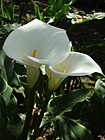Note: This is a project under development. The articles on this wiki are just being initiated and broadly incomplete. You can Help creating new pages.
Difference between revisions of "Zantedeschia aethiopica"
| Line 2: | Line 2: | ||
'''Zantedeschia aethiopica''' is a Evergreen Perennial up to 1.00 metres tall. It has uses. | '''Zantedeschia aethiopica''' is a Evergreen Perennial up to 1.00 metres tall. It has uses. | ||
==Uses== | ==Uses== | ||
| − | {{Uses|}}, {{Uses|}}, {{Uses|}}, {{Uses|}}, {{Uses|}}, {{Uses|}}, {{Uses| | + | {{Uses|Wounds}}, {{Uses|Boils}}, {{Uses|Minor burns}}, {{Uses|Insect bite}}, {{Uses|Sores}}, {{Uses|Rheumatism}}, {{Uses|Gout}}.<ref name="Uses"/> |
==Parts Used== | ==Parts Used== | ||
Latest revision as of 14:49, 8 September 2020
Zantedeschia aethiopica is a Evergreen Perennial up to 1.00 metres tall. It has uses.
Contents
- 1 Uses
- 2 Parts Used
- 3 Chemical Composition
- 4 Common names
- 5 Properties
- 6 Habit
- 7 Identification
- 8 List of Ayurvedic medicine in which the herb is used
- 9 Where to get the saplings
- 10 Mode of Propagation
- 11 How to plant/cultivate
- 12 Commonly seen growing in areas
- 13 Photo Gallery
- 14 References
- 15 External Links
Uses
Wounds, Boils, Minor burns, Insect bite, Sores, Rheumatism, Gout.[1]
Parts Used
[[:Category:Herbs with used in medicine|]], stem, leaves, Root.
Chemical Composition
Chemical constituents present within Z. aethiopica have been identified using spectroscopy, including two cycloartane triterpenes, 10 sterols, three lignans, and 10 phenylpropanoids etc[2]
Common names
| Language | Common name |
|---|---|
| Kannada | |
| Hindi | |
| Malayalam | |
| Tamil | |
| Telugu | |
| Marathi | |
| Gujarathi | |
| Punjabi | |
| Kashmiri | |
| Sanskrit | |
| English |
Properties
Reference: Dravya - Substance, Rasa - Taste, Guna - Qualities, Veerya - Potency, Vipaka - Post-digesion effect, Karma - Pharmacological activity, Prabhava - Therepeutics.
Dravya
Rasa
Guna
Veerya
Vipaka
Karma
Prabhava
Habit
Identification
Leaf
| Kind | Shape | Feature |
|---|---|---|
Flower
| Type | Size | Color and composition | Stamen | More information |
|---|---|---|---|---|
| {{{5}}} |
Fruit
| Type | Size | Mass | Appearance | Seeds | More information |
|---|---|---|---|---|---|
Other features
List of Ayurvedic medicine in which the herb is used
Where to get the saplings
Mode of Propagation
How to plant/cultivate
Requires a very rich soil in full sun or shade. Best when growing in full sun. Succeeds in wet soils or water up to 30cm deep. [4]
Commonly seen growing in areas
Photo Gallery
References
- ↑ Indian Medicinal Plants by C.P.Khare
- ↑ Chemical constituents
- ↑ [Morphology]
- ↑ Cultivation
External Links
- Ayurvedic Herbs known to be helpful to treat Wounds
- Ayurvedic Herbs known to be helpful to treat Boils
- Ayurvedic Herbs known to be helpful to treat Minor burns
- Ayurvedic Herbs known to be helpful to treat Insect bite
- Ayurvedic Herbs known to be helpful to treat Sores
- Ayurvedic Herbs known to be helpful to treat Rheumatism
- Ayurvedic Herbs known to be helpful to treat Gout
- Herbs with used in medicine
- Herbs with stem used in medicine
- Herbs with leaves used in medicine
- Herbs with Root used in medicine
- Habit - Evergreen perennial
- Index of Plants which can be propagated by Seeds
- Herbs that are commonly seen in the region of Wet marshy places
- Herbs





